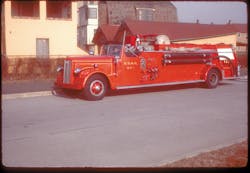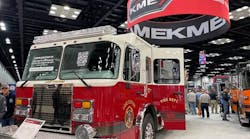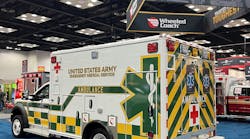For more than 100 years, fire departments have been operating with motorized ladder company apparatus. Seagrave Fire Apparatus is credited with delivering the first motor-driven city service tractor-drawn ladder truck to the City of Los Angeles in 1911. Other manufacturers, including American LaFrance, Mack and Maxim Motors, quickly followed suit with their entries into the market.
It was not until 1935 that Peter Pirsch and Sons in Kenosha, WI, delivered the first all-metal hydraulically powered 100-foot aerial ladder to the Melrose, MA, Fire Department. During that period, most departments were operating with 20-year-old, spring-raised wooden aerials with motorized tractors that had been rebuilt from the horse-drawn era.
Quad units gain favor
The development of hydraulically raised metal aerial ladders was at the time one of the most significant innovations in the fire service. Many fire departments continued to favor wooden aerial ladders, with both Chicago and New York City ordering these types of tractor-drawn ladders through the mid-1950s. For those departments that did not require an aerial ladder, the quad apparatus became an attractive unit to acquire. The city-service ladder had somewhat fallen out of favor with the quad equipped a fire pump, booster tank, hosebed and ground ladders. As communities developed after World War II, there was a resurgence in purchasing new apparatus, with the versatility of quad units gaining favor.
The Ward La France Co. of Elmira Heights, NY, built a number of massive quad units during that period. These trucks were capable of carrying more than 250 feet of ground ladders and were more than 42 feet long. In 1951, New York City placed into service seven Ward La France open-cab quads that were equipped with a 750-gpm pump and a 250-gallon booster tank. Two of these units were assigned to Staten Island ladder companies with the others at engine companies that were remote from adjacent ladder companies.
Aerial devices built during the 1950s were equally split between tractor-drawn and straight-frame ladders with aerials ranging from 65 feet to 100 feet. With the introduction of the cab-forward chassis design by American La France, fire departments were now presented with a choice of seating arrangements where two firefighters could be seated in rear-facing jump seats. The cab-forward design provided for a shorter overall length vehicle with an improved turning radius over conventional, engine-forward apparatus. Other manufacturers including Mack, Maxim Motors and Seagrave, waited to see if cab-forward apparatus would be universally accepted by departments; by 1959, all major apparatus builders had introduced cab-forward designs. While aerial ladder technology had not changed much over the preceding 20 years, the advances in chassis configuration would greatly impact how aerial ladders would be engineered and built.
In September 1958, the Pitman Co. delivered the first Snorkel device, a 50-foot articulating platform, to the Chicago Fire Department, under the direction of Commissioner Robert Quinn. For the next 20 years, the Snorkel and its competitors proved their worth at major incidents across the country with their ability to deliver master streams with pinpoint accuracy and enabling personnel to go up and over obstructions such as power lines, trees and parapet walls. The concept of operating safely inside a platform would eventually lead to the development of the aerial platform and tower ladder apparatus.
The quad apparatus was replaced by the quint and with the addition of an aerial ladder or elevating platform the quint became the Swiss Army knife of fire apparatus. When combined with a cab forward chassis the quint provided a shorter wheelbase and overall length with the ability to fit into a fire station with a ten foot overhead door.
American La France somewhat pioneered the quint with its introduction of the 900 series cab-forward chassis. These devices had an overall height of just 110 inches with a 100-foot ladder, an overall length of 43 feet, five inches and capable of carrying 1,500 feet of 2½-inch hose and 208 feet of ground ladders. These vehicles proved to be not only versatile, but were compact in size when compared to comparable-height platform devices.
Aerial apparatus had traditionally been built with open cabs to provide clear vision for the crew, giving them the ability to position the rig while looking for overhead wires and other obstructions. Open-cab vehicles also provided over overall travel heights which were critical when housing aerial apparatus in older stations with limited door clearances.
Rear-mount ladders
Seagrave Fire Apparatus introduced the Rear Admiral ladder in 1964 with a new rear-mounted aerial ladder design. This device provided a shorter overall length vehicle and often replaced older, tractor-drawn ladders in some departments, including New York, Baltimore and Chicago.
The Seagrave rear-mount ladder was built with a 226-inch wheelbase and overall length of 34 feet, 10 inches, considerably shorter than midship or tractor-drawn units, and still able to fit into stations with limited door clearance. Beginning in 1969, New York City experimented with rear-mount aerials and has enjoyed success with the rear-mount units.
The decade of the 1960s was one of the most transformational periods in aerial device engineering and design. The success of the Snorkel articulating platforms led several other apparatus builders to produce telescopic aerial platforms, which would give fire departments even more choices when acquiring new units.
Mack and Sutphen, followed in later years by Grove and LTI, introduced both midship- and rear-mounted tower apparatus. In addition, several European aerial manufacturers partnered with U.S. builders to offer rear-mount aerial ladders with working heights of up to 144 feet. While never gaining wide popularity with departments with their inability to carry a sufficient quantity of ground ladders, there was now an almost overwhelming number of aerial device choices.
The term “tower ladder” was coined in 1964 ,when the FDNY placed into service its first 75-foot telescopic platform. Over the years, New York City placed into service approximately 178 Mack tower ladders on both single- and tandem-axle chassis. When the definitive history of aerial devices is written, the Mack-Baker 75-foot tower ladder will be viewed as one of the most versatile and battle-proven apparatus of all time. Many of these venerable rigs are serving with their second and third fire departments, with others have been re-mounted on newer-model chassis with enhancements to bring them into compliance with the current National Fire Protection Association (NFPA) 1901, Standard for Automotive Fire Apparatus.
Tractor-drawn ladders
Tractor-drawn ladders continue to be the favored style of device with many departments, including Baltimore, Los Angeles City, San Francisco and Seattle. Tiller units, while they require a lot of apparatus bay space and enhanced driver/operator training, provide the greatest amount of space for tools and equipment as well as the ability to carry more than 300 feet of ground ladders both inside the trailer and along the sides of the body. Several departments on the West Coast have placed into service “quiller” units that provide for a fire pump and water tank on the tractor together with pre-connected attack lines and storage areas for supply lines.
Aerial devices of any type are the most expensive piece of apparatus a fire department will acquire. Careful consideration to the type of apparatus that will best meet the needs of the response area and provide sufficient equipment and ground ladder capabilities must be reviewed when developing specifications for new truck company units.






